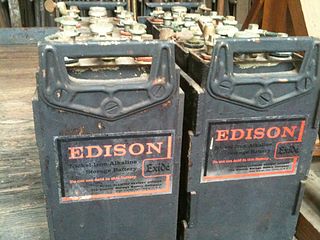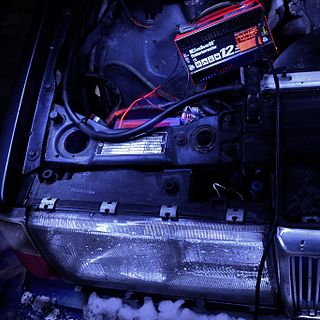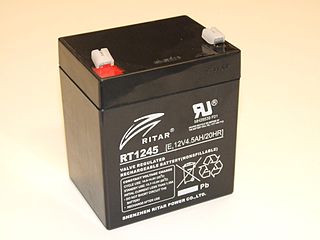Related Research Articles

A nickel–metal hydride battery is a type of rechargeable battery. The chemical reaction at the positive electrode is similar to that of the nickel-cadmium cell (NiCd), with both using nickel oxide hydroxide (NiOOH). However, the negative electrodes use a hydrogen-absorbing alloy instead of cadmium. NiMH batteries can have two to three times the capacity of NiCd batteries of the same size, with significantly higher energy density, although only about half that of lithium-ion batteries.

The nickel–cadmium battery is a type of rechargeable battery using nickel oxide hydroxide and metallic cadmium as electrodes. The abbreviation Ni–Cd is derived from the chemical symbols of nickel (Ni) and cadmium (Cd): the abbreviation NiCad is a registered trademark of SAFT Corporation, although this brand name is commonly used to describe all Ni–Cd batteries.

A lithium-ion or Li-ion battery is a type of rechargeable battery that uses the reversible intercalation of Li+ ions into electronically conducting solids to store energy. In comparison with other commercial rechargeable batteries, Li-ion batteries are characterized by higher specific energy, higher energy density, higher energy efficiency, a longer cycle life, and a longer calendar life. Also noteworthy is a dramatic improvement in lithium-ion battery properties after their market introduction in 1991: over the following 30 years, their volumetric energy density increased threefold while their cost dropped tenfold.

A rechargeable battery, storage battery, or secondary cell, is a type of electrical battery which can be charged, discharged into a load, and recharged many times, as opposed to a disposable or primary battery, which is supplied fully charged and discarded after use. It is composed of one or more electrochemical cells. The term "accumulator" is used as it accumulates and stores energy through a reversible electrochemical reaction. Rechargeable batteries are produced in many different shapes and sizes, ranging from button cells to megawatt systems connected to stabilize an electrical distribution network. Several different combinations of electrode materials and electrolytes are used, including lead–acid, zinc–air, nickel–cadmium (NiCd), nickel–metal hydride (NiMH), lithium-ion (Li-ion), lithium iron phosphate (LiFePO4), and lithium-ion polymer.

The lead-acid battery is a type of rechargeable battery first invented in 1859 by French physicist Gaston Planté. It is the first type of rechargeable battery ever created. Compared to modern rechargeable batteries, lead-acid batteries have relatively low energy density. Despite this, they are able to supply high surge currents. These features, along with their low cost, make them attractive for use in motor vehicles to provide the high current required by starter motors. Lead-acid batteries suffer from relatively short cycle lifespan and overall lifespan, as well as long charging times.

An automotive battery, or car battery, is a rechargeable battery that is used to start a motor vehicle.

The nickel–iron battery is a rechargeable battery having nickel(III) oxide-hydroxide positive plates and iron negative plates, with an electrolyte of potassium hydroxide. The active materials are held in nickel-plated steel tubes or perforated pockets. It is a very robust battery which is tolerant of abuse, and can have very long life even if so treated. It is often used in backup situations where it can be continuously charged and can last for more than 20 years. Due to its low specific energy, poor charge retention, and high cost of manufacture, other types of rechargeable batteries have displaced the nickel–iron battery in most applications.
Peukert's law, presented by the German scientist Wilhelm Peukert in 1897, expresses approximately the change in capacity of rechargeable lead–acid batteries at different rates of discharge. As the rate of discharge increases, the battery's available capacity decreases, approximately according to Peukert's law.

A battery charger, recharger, or simply charger, is a device that stores energy in an electric battery by running current through it. The charging protocol—how much voltage, current, for how long and what to do when charging is complete—depends on the size and type of the battery being charged. Some battery types have high tolerance for overcharging after the battery has been fully charged and can be recharged by connection to a constant voltage source or a constant current source, depending on battery type.

A nickel–zinc battery is a type of rechargeable battery similar to nickel–cadmium batteries, but with a higher voltage of 1.6 V.

A valve regulated lead-acid (VRLA) battery, commonly known as a sealed lead-acid (SLA) battery, is a type of lead-acid battery characterized by a limited amount of electrolyte absorbed in a plate separator or formed into a gel; proportioning of the negative and positive plates so that oxygen recombination is facilitated within the cell; and the presence of a relief valve that retains the battery contents independent of the position of the cells.

The lithium iron phosphate battery or LFP battery is a type of lithium-ion battery using lithium iron phosphate as the cathode material, and a graphitic carbon electrode with a metallic backing as the anode. Because of their low cost, high safety, low toxicity, long cycle life and other factors, LFP batteries are finding a number of roles in vehicle use, utility-scale stationary applications, and backup power. LFP batteries are cobalt-free. As of September 2022, LFP type battery market share for EVs reached 31%, and of that, 68% were from EV makers Tesla and BYD alone. Chinese manufacturers currently hold a near monopoly of LFP battery type production. With patents having started to expire in 2022 and the increased demand for cheaper EV batteries, LFP type production is expected to rise further and surpass lithium nickel manganese cobalt oxides (NMC) type batteries in 2028.
State of charge (SoC) quantifies the remaining capacity available in a battery at a given time and in relation to a given state of ageing. It is usually expressed as percentage. An alternative form of the same measure is the depth of discharge (DoD), calculated as 1 − SoC. It refers to the amount of charge that may be used up if the cell is fully discharged. State of charge is normally used when discussing the current state of a battery in use, while depth of discharge is most often used to discuss a constant variation of state of charge during repeated cycles.

Battery recycling is a recycling activity that aims to reduce the number of batteries being disposed as municipal solid waste. Batteries contain a number of heavy metals and toxic chemicals and disposing of them by the same process as regular household waste has raised concerns over soil contamination and water pollution. While reducing the amount of pollutants being released through disposal through the uses of landfill and incineration, battery recycling can facilitate the release of harmful materials from batteries to both the environment and the workers recycling batteries.
Float voltage is the voltage at which a battery is maintained after being fully charged to maintain that capacity by compensating for self-discharge of the battery. The voltage could be held constant for the entire duration of the cell's operation or could be held for a particular phase of charging by the charger. The appropriate float voltage varies significantly with the chemistry and construction of the battery, and ambient temperature.

An electric vehicle battery is a rechargeable battery used to power the electric motors of a battery electric vehicle (BEV) or hybrid electric vehicle (HEV).
A battery management system (BMS) is any electronic system that manages a rechargeable battery by facilitating the safe usage and a long life of the battery in practical scenarios while monitoring and estimating its various states, calculating secondary data, reporting that data, controlling its environment, authenticating or balancing it. Protection circuit module (PCM) is a simpler alternative to BMS. A battery pack built together with a battery management system with an external communication data bus is a smart battery pack. A smart battery pack must be charged by a smart battery charger.

An electric battery is a source of electric power consisting of one or more electrochemical cells with external connections for powering electrical devices. When a battery is supplying power, its positive terminal is the cathode and its negative terminal is the anode. The terminal marked negative is the source of electrons that will flow through an external electric circuit to the positive terminal. When a battery is connected to an external electric load, a redox reaction converts high-energy reactants to lower-energy products, and the free-energy difference is delivered to the external circuit as electrical energy. Historically the term "battery" specifically referred to a device composed of multiple cells; however, the usage has evolved to include devices composed of a single cell.
A charge cycle is the process of charging a rechargeable battery and discharging it as required into a load. The term is typically used to specify a battery's expected life, as the number of charge cycles affects life more than the mere passage of time. Discharging the battery fully before recharging may be called "deep discharge"; partially discharging then recharging may be called "shallow discharge".
This glossary of civil engineering terms is a list of definitions of terms and concepts pertaining specifically to civil engineering, its sub-disciplines, and related fields. For a more general overview of concepts within engineering as a whole, see Glossary of engineering.
References
- ↑ General Electric Company; General Electric Company. Publicity Dept (1934). General Electric review. General Electric Co. Retrieved 12 January 2012.
- ↑ George Wood Vinal (December 1955). Storage batteries: a general treatise on the physics and chemistry of secondary batteries and their engineering applications. Wiley. ISBN 9780471908166 . Retrieved 12 January 2012.
- ↑ InfoWorld Media Group, Inc. (28 August 1989). InfoWorld. InfoWorld Media Group, Inc. p. 29. ISSN 0199-6649 . Retrieved 12 January 2012.
- ↑ David Anthony James Rand (24 February 2004). Valve-regulated lead-acid batteries. Elsevier. p. 258. ISBN 978-0-444-50746-4 . Retrieved 12 January 2012.
- ↑ Thomas Roy Crompton (11 May 2000). Battery reference book. Newnes. p. 47. ISBN 978-0-7506-4625-3 . Retrieved 12 January 2012.
- ↑ Henk Jan Bergveld; Wanda S. Kruijt; Peter H. L. Notten (1 November 2002). Battery management systems: design by modelling. Springer. p. 171. ISBN 978-1-4020-0832-0 . Retrieved 12 January 2012.